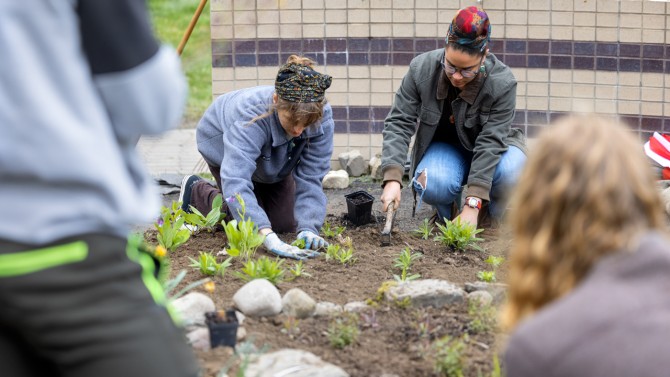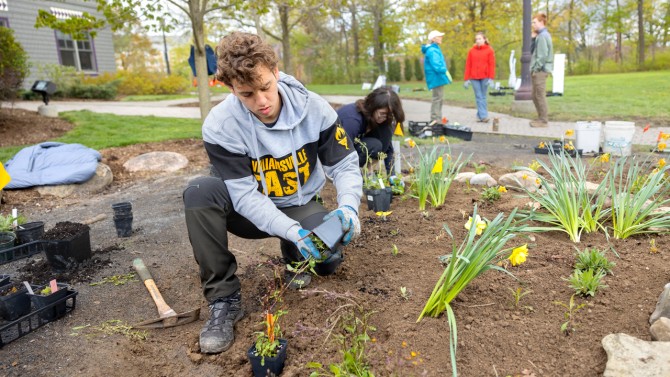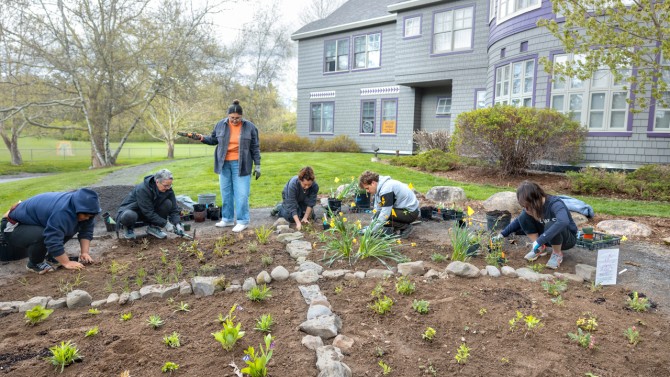Native students at Cornell collaborate with Cornell Botanic Gardens and students from its Learning by Leading program to create a healing and honoring medicinal garden in front of Akwe:kon, the nation's first university residence hall established to celebrate American Indian culture and heritage.
Collaboration brings healing, honoring garden to Akwe:kon
By Caitlin Hayes, Cornell Chronicle
One night in late January, two groups of students came together to plan a garden. With markers and crayons, they drew their aspirations and ideas on large sheets of paper. They talked about plants and meaning, about culture, hope and healing.
Because this wasn’t just any garden.
A group of Indigenous students from the American Indian and Indigenous Studies Program (AIISP) had brought their idea of a medicinal garden to students and staff from Cornell Botanic Gardens’ Learning by Leading program. Together, they established the Akwe:kon Full Circle Healing and Honoring Garden, which aims to further bond Cornell’s Indigenous student community and to honor Indigenous students and their connection to the land.
“We’ve been talking about a garden for a long time,” said Yanenowi Logan ‘24 (Seneca), an environment and sustainability major in the College of Agriculture and Life Sciences. “But it’s not just a garden – this was an opportunity to build community with each other and with the land we have. With the native plants and traditional plants – it contributes to this whole ecosystem of Indigeneity.”
Students from AIISP and the Learning by Leading program planted the garden at the entrance of Akwe:kon, the nation’s first university residential hall devoted to celebrating American Indian culture and heritage. Learning by Leading is a new program that allows students to take the lead on project teams related to sustainability, outreach and horticulture.
“This project is giving our students really valuable real-world opportunities,” said Sonja Skelly, director of education at Cornell Botanic Gardens and adjunct associate professor of horticulture in the School of Integrative Plant Science in CALS. “The AIISP students have a vision and goals, and our students have to figure out how to achieve that.”
Established in 1991, Akwe:kon is celebrating its 30th anniversary this year, after a pandemic delay. An anniversary celebration and garden dedication were held May 5 at Akwe:kon, where the Akwesasne Women Singers, with Theresa Bear Fox, sang healing and growth songs in Mohawk, and Steve Henhawk (Gayogohó:nǫˀ/Cayuga), research associate in AIISP, offered remarks in his native Gayogohó:nǫˀ, the Indigenous language of the land on which Cornell sits.
“Akwe:kon was established to give Indigenous students a sense of community, a special place where they could connect, both over their Indigenous experiences, and through culture, through engagement,” said Leslie Logan (Seneca), associate director of AIISP (and Yanenowi Logan’s mother). “The garden is another opportunity for students to cement those relationships, not only between themselves, but with the land and natural resources, which is so much a part of many of our cultures’ identities.”
“This has been such a rich process,” Skelly said. “For our Learning by Leading students, it goes beyond giving them learning opportunities and a client relationship, to where they’re really developing cultural understanding. And that’s part of our mission – to truly understand how culture and nature are inextricably linked.”
Building a relationship
Designing and populating the garden required multiple collaborative sessions that benefited both groups. Ten students from the Learning by Leading Sustainable Landscapes Team and a core group of about 15 AIISP students explored possibilities and revised plans based on the availability and viability of different species, also taking into consideration how the garden could offer something in every season. Learning by Leading students went to Akwe:kon; AIISP students went to the greenhouses at Cornell Botanic Gardens.
“We’ve really built a relationship with people who bring different sets of knowledge,” said Coco Dawkins ‘24, a landscape architecture major in CALS and Sustainable Landscapes Team co-leader, with Kaitlin Fisher '24, an environment and sustainability major in CALS. “And both groups have literally had their hands in the garden, whether it’s drawing or planting seeds, transplanting plants, to ultimately planting the garden together. I think that’s pretty unique.”
A circular plot of grass in front of Akwe:kon provided inspiration – and the group settled on a design that shares characteristics with a medicine wheel, a sacred symbol in many Native cultures.
“The circle has so much power in traditional beliefs and symbolizes how hope and wholeness is restorative and reciprocal,” Yanenowi Logan said. “For that to be the shape of the garden was just perfect.”
The garden will include native plants known to be used in Indigenous communities, many with ceremonial uses, including sage, strawberries, tobacco and sweetgrass. One non-native plant, daffodils, will be included to honor and remember Daniela Lee ’22 (Mohawk and Tarahumara), a Cornell student and ardent nature lover who died last year.
“We’re so glad the garden will honor Daniela,” Leslie Logan said, “and also celebrate all of the Indigenous students who have walked the halls of Akwe:kon and on the Cornell campus, and who have walked on.”
Signposts will eventually identify the plants in English and Gayogohó:nǫˀ, and QR codes will link to information about their Indigenous uses. AIISP students collected and painted rocks that now surround the garden.
The AIISP students said the Learning by Leading team made their ideas feel possible.
“It didn’t feel like it would really happen until we sat down with these people we didn’t know,” said Grant Whitman ’25 (Nakota Aaniiih), a biology and chemistry double major in the College of Arts and Sciences. “We all came together and started working towards this shared vision – that’s when it started to feel real.”
And there was a significant exchange of information on both sides: AIISP students were awed by the depth of knowledge of botanic gardens staff and students – they said they learned how much planning goes into a garden, as well as surprising facts about invasive worms and cactuses native to New York.
“When we were sowing seeds, we talked about the different sizes of the seeds and how they need different care and attention, how you have to shake seeds up with rocks, so they disperse evenly,” Yanenowi Logan said. “What I took away from that is that there’s no perfect equation, no knowing if you got it right. Something’s always changing. That was pretty cool and pretty powerful.”
Botanic gardens students said the collaboration led to a deeper and more meaningful learning.
“We can look up ‘medicine wheel’ and look at the images, but here we’ve learned by doing, and it’s made it so interconnected, thinking through the way we’ll use plants to represent the wheel,” Dawkins said. “The whole project has reminded me that there’s always a history to the land we’re using and to stay really open to the exchange of information.”
As the garden matures, the groups hope it will provide comfort for the Indigenous student community, through harvesting the medicinal herbs, learning about their meaning and uses, and appreciating the garden’s beauty and the community that built it.
“Native students need community, and we need that relationship with the land,” Yanenowi Logan said. “I’m really grateful we have a community that’s dedicated, engaged and able to move this project forward.”
Media Contact
Abby Kozlowski
Get Cornell news delivered right to your inbox.
Subscribe



